Botanical
Name: Aesculus hippocastanum
Common Name: horse chestnut
Family: Sapindaceae
Distribution/Origin: Europe
Leaf: palmately compound, doubly serrate margins, obovate with acuminate tips
Bud: big sticky buds, opposite
Flower: erect white panicle, red center, perfect
Fruit/Seed: green capsule, spiny and nut like, splits along carpel lines to reveal seed
Stem/Bark: distinctive leaf scars in horseshoe shape, plated, grey-brown
Size: 22-30m height, 15-25m spread
Habit: multistemmed, ascending, pendulous curled up tips
Form: globose, domed crown
Soil Conditions: well drained, adaptable, can grow in nutritionally poor soils, prefers deep and loamy
Moisture: even moisture
Sun: full sun to partial shade
Exposure: can handle strong winds, pollution
Landscape Use: street tree, large areas
Notes: the roasted seed is often used as a coffee substitute
Common Name: horse chestnut
Family: Sapindaceae
Distribution/Origin: Europe
Leaf: palmately compound, doubly serrate margins, obovate with acuminate tips
Bud: big sticky buds, opposite
Flower: erect white panicle, red center, perfect
Fruit/Seed: green capsule, spiny and nut like, splits along carpel lines to reveal seed
Stem/Bark: distinctive leaf scars in horseshoe shape, plated, grey-brown
Size: 22-30m height, 15-25m spread
Habit: multistemmed, ascending, pendulous curled up tips
Form: globose, domed crown
Soil Conditions: well drained, adaptable, can grow in nutritionally poor soils, prefers deep and loamy
Moisture: even moisture
Sun: full sun to partial shade
Exposure: can handle strong winds, pollution
Landscape Use: street tree, large areas
Notes: the roasted seed is often used as a coffee substitute


Botanical
Name: Catalpa bignonioides
Common Name: cigar tree
Family: Bignoniaceae
Distribution/Origin: eastern United States
Leaf: rounded tips, broad, cordate base
Bud: opposite
Flower: panicles, trumpet shaped,
Fruit/Seed: long thin bean pod, flat light brown seeds with papery wings
Stem/Bark: brown to grey bark, plated, ridged
Size: 49-59’ height, 20-40’ spread
Habit: bushy
Form: irregular broad rounded crown
Soil Conditions: moist fertile loams, well drained
Moisture: medium to wet
Sun: full sun to partial shade
Exposure: sheltered
Landscape Use: shade tree, rain garden
Notes: the leaves emit a strange aroma when bruised
Common Name: cigar tree
Family: Bignoniaceae
Distribution/Origin: eastern United States
Leaf: rounded tips, broad, cordate base
Bud: opposite
Flower: panicles, trumpet shaped,
Fruit/Seed: long thin bean pod, flat light brown seeds with papery wings
Stem/Bark: brown to grey bark, plated, ridged
Size: 49-59’ height, 20-40’ spread
Habit: bushy
Form: irregular broad rounded crown
Soil Conditions: moist fertile loams, well drained
Moisture: medium to wet
Sun: full sun to partial shade
Exposure: sheltered
Landscape Use: shade tree, rain garden
Notes: the leaves emit a strange aroma when bruised
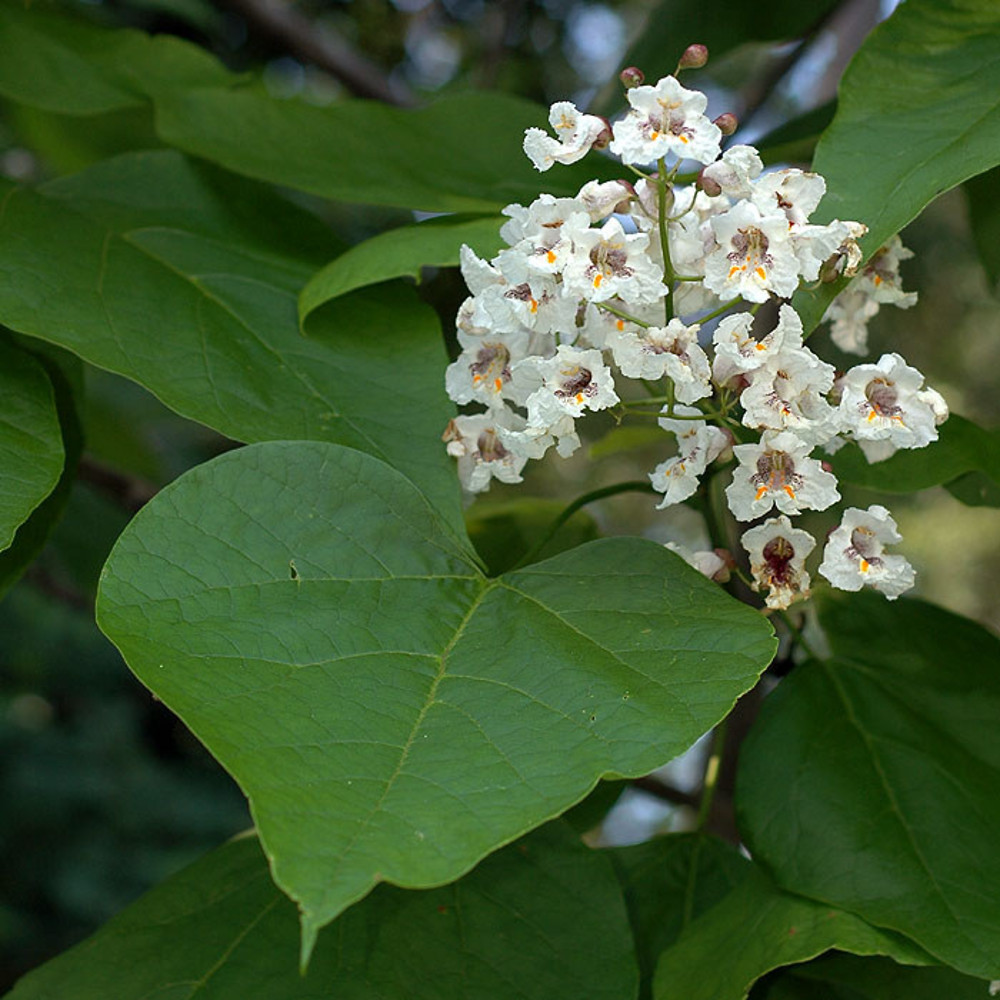

Botanical
Name: Catalpa speciosa
Common Name: northern catalpa
Family: Bignoniaceae
Distribution/Origin: Midwestern United States
Leaf: opposite, whorled, heart shaped, pointed apex, softly hairy undersides
Bud: terminal bud absent, lateral buds are small, covered with red brown scales
Flower: panicles, trumpet shaped, yellow stripes and purple spots inside
Fruit/Seed: long thin legume like pod
Stem/Bark: light lenticiles, separated into irregular shallow fissures and scaly ridges
Size: 40-70’ height, 20-40’ spread
Habit: multistemmed, spreading irregular branching habit
Form: upright
Soil Conditions: well drained, fertile
Moisture: evenly moist
Sun: full sun
Exposure: sheltered, leaves may shred if in strong winds
Landscape Use: large shade tree, flowering tree
Notes: the wood has one of the lowest shrinkage/expansion rates of any US woods
Common Name: northern catalpa
Family: Bignoniaceae
Distribution/Origin: Midwestern United States
Leaf: opposite, whorled, heart shaped, pointed apex, softly hairy undersides
Bud: terminal bud absent, lateral buds are small, covered with red brown scales
Flower: panicles, trumpet shaped, yellow stripes and purple spots inside
Fruit/Seed: long thin legume like pod
Stem/Bark: light lenticiles, separated into irregular shallow fissures and scaly ridges
Size: 40-70’ height, 20-40’ spread
Habit: multistemmed, spreading irregular branching habit
Form: upright
Soil Conditions: well drained, fertile
Moisture: evenly moist
Sun: full sun
Exposure: sheltered, leaves may shred if in strong winds
Landscape Use: large shade tree, flowering tree
Notes: the wood has one of the lowest shrinkage/expansion rates of any US woods

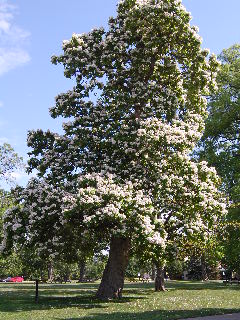
Botanical
Name: Cercidiphyllum japonicum
Common Name: Catsura
Family: Cercidiphylaceae
Distribution/Origin:
Leaf: simple opposite, broad ovate in shape, cordate base, crenate margins
Bud: sub opposite, sub alternate (variable) looks like claws, hold tight to stem, twin terminal shaped like beak/lobster claw
Flower: green and not showy
Fruit/Seed: small pods with winged seeds
Stem/Bark: fissured, exfoliates in strips, lightly lenticiled
Size: 40-50’ height, 20-30’ spread
Habit: ascending branches, twiggy, spreading
Form: dense crown, pyramidal
Soil Conditions: rich well drained soils, pH adaptable
Moisture: consistent moisture
Sun: sun to partial shade
Exposure:
Landscape Use: parks, large lawns, golf courses, street tree
Notes: extremely deliciously fragrant foliage!
Common Name: Catsura
Family: Cercidiphylaceae
Distribution/Origin:
Leaf: simple opposite, broad ovate in shape, cordate base, crenate margins
Bud: sub opposite, sub alternate (variable) looks like claws, hold tight to stem, twin terminal shaped like beak/lobster claw
Flower: green and not showy
Fruit/Seed: small pods with winged seeds
Stem/Bark: fissured, exfoliates in strips, lightly lenticiled
Size: 40-50’ height, 20-30’ spread
Habit: ascending branches, twiggy, spreading
Form: dense crown, pyramidal
Soil Conditions: rich well drained soils, pH adaptable
Moisture: consistent moisture
Sun: sun to partial shade
Exposure:
Landscape Use: parks, large lawns, golf courses, street tree
Notes: extremely deliciously fragrant foliage!

Botanical
Name: Cryptomeria japonica
Common Name: Japanese cedar
Family: Taxodiaceae
Distribution/Origin: Japan
Leaf: evergreen, spirally arranged, awl shaped needles, persist 4-5 years, glossy
Bud: opposite, small, not scaly
Flower: male and female flowers
Fruit/Seed: terminal, globe shaped, dark brown in color
Stem/Bark: reddish brown, shreds in long strips
Size: over 30’ height, 15-30’ spread
Habit: central leader,
Form: conical, columnar, pyramidal
Soil Conditions: deep, slightly acidic
Moisture: water consistently, medium moisture
Sun: part sun to full sun
Exposure: protect from high winds
Landscape Use: screening, focal point,
Notes: Japans national tree
Common Name: Japanese cedar
Family: Taxodiaceae
Distribution/Origin: Japan
Leaf: evergreen, spirally arranged, awl shaped needles, persist 4-5 years, glossy
Bud: opposite, small, not scaly
Flower: male and female flowers
Fruit/Seed: terminal, globe shaped, dark brown in color
Stem/Bark: reddish brown, shreds in long strips
Size: over 30’ height, 15-30’ spread
Habit: central leader,
Form: conical, columnar, pyramidal
Soil Conditions: deep, slightly acidic
Moisture: water consistently, medium moisture
Sun: part sun to full sun
Exposure: protect from high winds
Landscape Use: screening, focal point,
Notes: Japans national tree
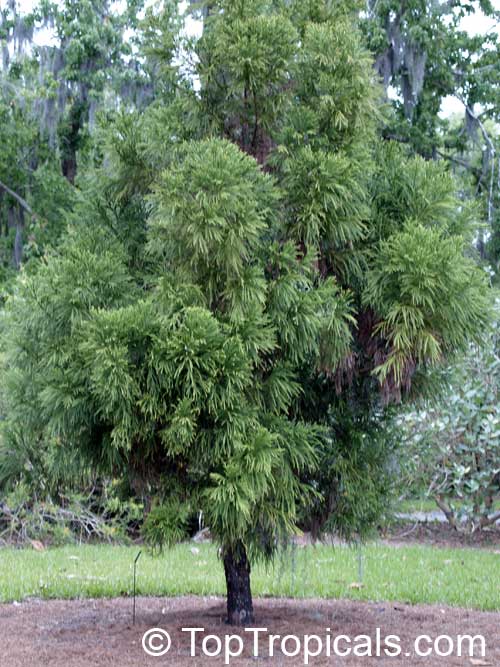
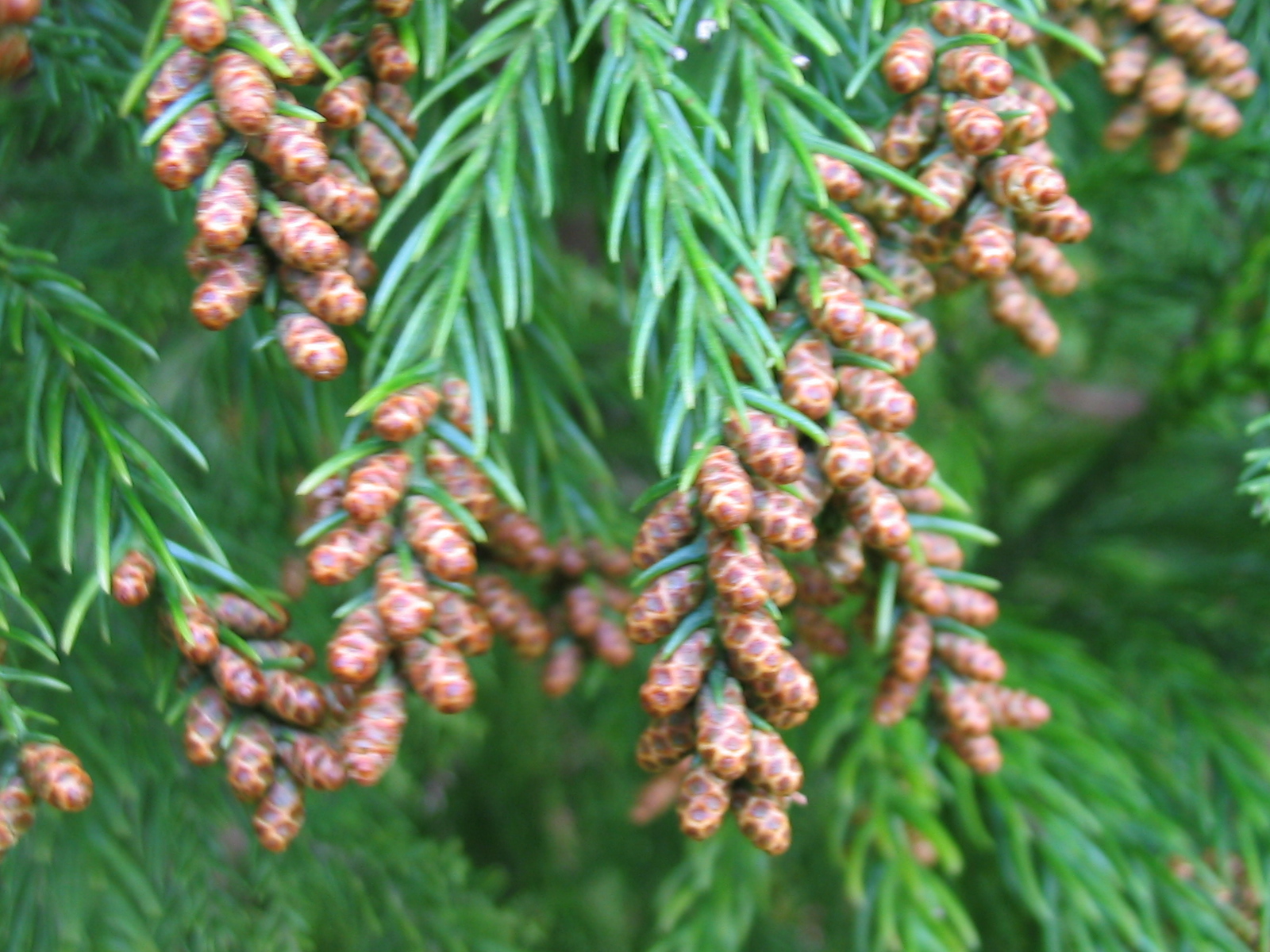
Botanical Name: Fagus sylvatica
Common Name: European beech
Family: Fagaceae
Distribution/Origin: Europe
Leaf: alternate, pubescent and deeply pinnate veins, undulate margins
Bud: lance shaped, slender, flower buds are thicker
Flower: small catkins
Fruit/Seed: beech nuts, small, triangular, 2 nuts per capsule
Stem/Bark: resembling elephant legs, branch scars resemble eyes
Size: 82-115’ height, up to 26’ spread
Habit: ascending, long branches, multi stemmed, de-current
Form: wide, pyramidal
Soil Conditions: lean dry soils, well drained
Moisture: minimal moisture
Sun: full sun to partial shade
Exposure: sheltered from high winds, shallow root system
Landscape Use: hedging, screening
Notes: the eyes on the trunk were considered the “evil eye” in Bulgaria
Common Name: European beech
Family: Fagaceae
Distribution/Origin: Europe
Leaf: alternate, pubescent and deeply pinnate veins, undulate margins
Bud: lance shaped, slender, flower buds are thicker
Flower: small catkins
Fruit/Seed: beech nuts, small, triangular, 2 nuts per capsule
Stem/Bark: resembling elephant legs, branch scars resemble eyes
Size: 82-115’ height, up to 26’ spread
Habit: ascending, long branches, multi stemmed, de-current
Form: wide, pyramidal
Soil Conditions: lean dry soils, well drained
Moisture: minimal moisture
Sun: full sun to partial shade
Exposure: sheltered from high winds, shallow root system
Landscape Use: hedging, screening
Notes: the eyes on the trunk were considered the “evil eye” in Bulgaria


Botanical
Name: Ginkgo biloba
Common Name: maidenhair tree
Family: Ginkgoaceae
Distribution/Origin: China
Leaf: fan shaped, unique, stubby spur shoots
Bud: large, stubby spurs, orange-brown in color
Flower: pendulous yellow catkins (male), pendulous yellow-green peduncles (female)
Fruit/Seed: unpleasantly scented drupe containing single seed (smells like cheese!)
Stem/Bark: lightly fissured, grey, lignotubers on trunk (branches when stressed on crown)
Size: 50-80’ height, 30-40’ spread
Habit: erratic branching, angular crown, upright
Form: oval/vertical, pyramidal/widely
Soil Conditions: well draining, moist, sandy, tolerant of variety of soils
Moisture: even moisture
Sun: full sun
Exposure: resistant to wind and snow damage
Landscape Use: street tree, specimen tree, parks
Notes: a true living fossil!
Common Name: maidenhair tree
Family: Ginkgoaceae
Distribution/Origin: China
Leaf: fan shaped, unique, stubby spur shoots
Bud: large, stubby spurs, orange-brown in color
Flower: pendulous yellow catkins (male), pendulous yellow-green peduncles (female)
Fruit/Seed: unpleasantly scented drupe containing single seed (smells like cheese!)
Stem/Bark: lightly fissured, grey, lignotubers on trunk (branches when stressed on crown)
Size: 50-80’ height, 30-40’ spread
Habit: erratic branching, angular crown, upright
Form: oval/vertical, pyramidal/widely
Soil Conditions: well draining, moist, sandy, tolerant of variety of soils
Moisture: even moisture
Sun: full sun
Exposure: resistant to wind and snow damage
Landscape Use: street tree, specimen tree, parks
Notes: a true living fossil!

Botanical Name: Juglans
nigra
Common Name: black walnut
Family: Juglandaceae
Distribution/Origin: eastern North America
Leaf: alternate, odd pinnate, oblong in shape
Bud: greyish and fuzzy, lacking scales
Flower: male drooping catkins, female are terminal clusters
Fruit/Seed: semifleshy husk and brown corrugated nut
Stem/Bark: grey-black, deeply furrowed, pithy twigs with air spaces
Size: 75-100’ height, 75-100’ spread
Habit: absence of lower branching,
Form: oval to rounded
Soil Conditions: moist, organically rich, well draining
Moisture: medium
Sun: full sun
Exposure:
Landscape Use: shade tree, woodland gardens
Notes: hard black walnut shell is used in abrasive cleaners and water filtration. Native Americans used to throw the seed husks into the water to poison fish and make them easier to catch.
Common Name: black walnut
Family: Juglandaceae
Distribution/Origin: eastern North America
Leaf: alternate, odd pinnate, oblong in shape
Bud: greyish and fuzzy, lacking scales
Flower: male drooping catkins, female are terminal clusters
Fruit/Seed: semifleshy husk and brown corrugated nut
Stem/Bark: grey-black, deeply furrowed, pithy twigs with air spaces
Size: 75-100’ height, 75-100’ spread
Habit: absence of lower branching,
Form: oval to rounded
Soil Conditions: moist, organically rich, well draining
Moisture: medium
Sun: full sun
Exposure:
Landscape Use: shade tree, woodland gardens
Notes: hard black walnut shell is used in abrasive cleaners and water filtration. Native Americans used to throw the seed husks into the water to poison fish and make them easier to catch.

Botanical Name: Liquidambar
styraciflua
Common Name: sweet gum tree
Family: Altingiaceae
Distribution/Origin: eastern North America, central Mexico
Leaf: sharply pointed palmate lobes, serrate margins
Bud: alternate, scaling
Flower: unisexual, covered in rusty hairs, terminal racemes
Fruit/Seed: compound fruit, composed of numerous capsules, containing 1-2 small seeds
Stem/Bark: attaches with plates, deeply scaled and fissured, layers of cork, lenticils present
Size: up to 75’ height, 50’ spread
Habit: bushy, symmetrical canopy
Form: broadly conical
Soil Conditions: widely adapted, well draining
Moisture: medium
Sun: partial shade
Exposure:
Landscape Use: flower borders and beds
Notes: the trees gum resin, for which it is named exudes from bark in the tree when wounded.
Common Name: sweet gum tree
Family: Altingiaceae
Distribution/Origin: eastern North America, central Mexico
Leaf: sharply pointed palmate lobes, serrate margins
Bud: alternate, scaling
Flower: unisexual, covered in rusty hairs, terminal racemes
Fruit/Seed: compound fruit, composed of numerous capsules, containing 1-2 small seeds
Stem/Bark: attaches with plates, deeply scaled and fissured, layers of cork, lenticils present
Size: up to 75’ height, 50’ spread
Habit: bushy, symmetrical canopy
Form: broadly conical
Soil Conditions: widely adapted, well draining
Moisture: medium
Sun: partial shade
Exposure:
Landscape Use: flower borders and beds
Notes: the trees gum resin, for which it is named exudes from bark in the tree when wounded.
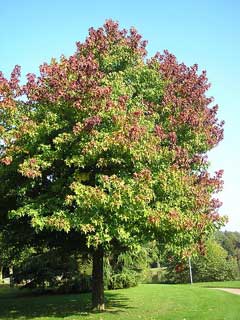
Botanical Name: Liriodendron
tulipifera
Common Name: tulip tree
Family: Magnoliaceae
Distribution/Origin: eastern North America
Leaf: alternate, simple, entire margins lobed, truncuate apex
Bud: dark red winter bud, flower bud enclosed in bracts
Flower: perfect, solitary, terminal, cup shaped
Fruit/Seed: narrow light brown cone, formed by samara like carpels
Stem/Bark: brown bark, furrowed, branchlets are smooth, aromatic and bitter
Size: 80-100’ height, 30-50’ spread
Habit: pyramidal in youth, irregular, spreading with age
Form: upright, strong central leader
Soil Conditions: deep, rich, well draining, acidic
Moisture: evenly moist
Sun: full sun
Exposure:
Landscape Use: large lots, focal point, shade tree
Notes: there is a tree in the New York metro area called the “Queens Giant”, which is 350-450 years old, making it the oldest living tree in that area.
Common Name: tulip tree
Family: Magnoliaceae
Distribution/Origin: eastern North America
Leaf: alternate, simple, entire margins lobed, truncuate apex
Bud: dark red winter bud, flower bud enclosed in bracts
Flower: perfect, solitary, terminal, cup shaped
Fruit/Seed: narrow light brown cone, formed by samara like carpels
Stem/Bark: brown bark, furrowed, branchlets are smooth, aromatic and bitter
Size: 80-100’ height, 30-50’ spread
Habit: pyramidal in youth, irregular, spreading with age
Form: upright, strong central leader
Soil Conditions: deep, rich, well draining, acidic
Moisture: evenly moist
Sun: full sun
Exposure:
Landscape Use: large lots, focal point, shade tree
Notes: there is a tree in the New York metro area called the “Queens Giant”, which is 350-450 years old, making it the oldest living tree in that area.
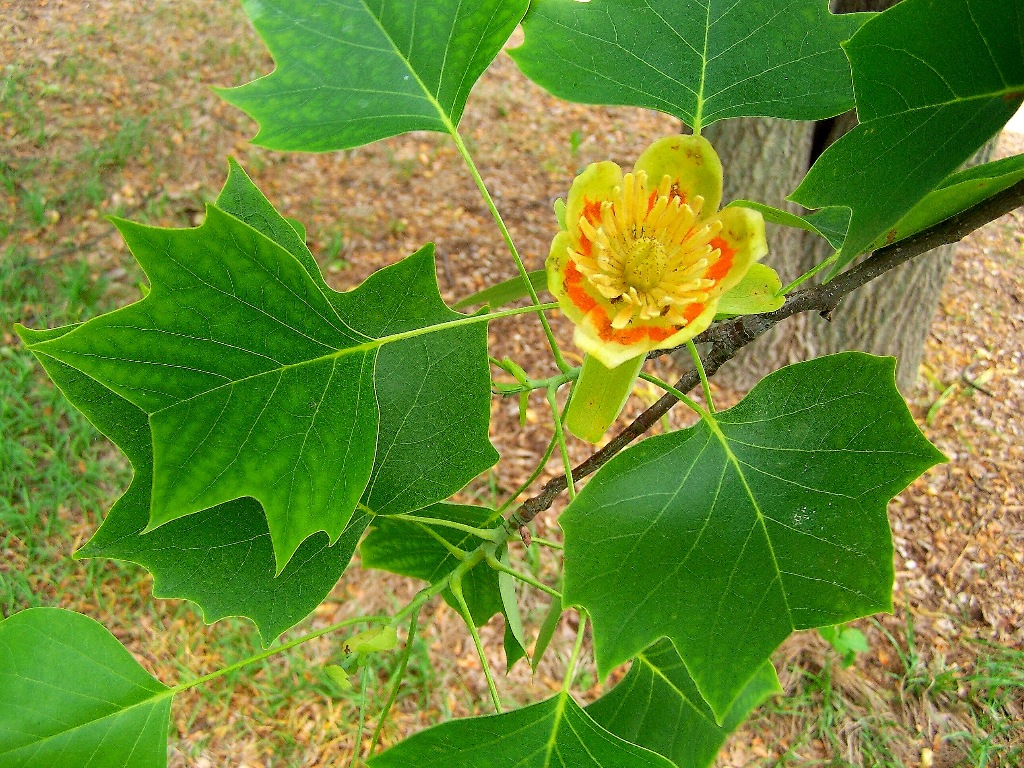
Botanical Name: Paulownia
tomentosa
Common Name: empress tree
Family: Paulowniaceae
Distribution/Origin: central and western China
Leaf: opposite, cordate base, heart shaped
Bud: brown buds, may freeze and drop off if too cold
Flower: very fragrant, panicles with tubular purple corollas
Fruit/Seed: dry egg shaped capsule, containing numerous tiny seeds
Stem/Bark: thin, greyish brown, shallowly fissured, numerous lenticils
Size: 8-12m height, wider than 8m
Habit: spreading, branched
Form: rounded crown, heavy clumsy branches
Soil Conditions: moist humus rich, fertile, well drained
Moisture: even moisture
Sun: full sun to partial shade
Exposure: tolerant of pollution
Landscape Use: focal point, garden tree, large areas
Notes: can survive because the roots can regenerate new very fast growing stems.
Common Name: empress tree
Family: Paulowniaceae
Distribution/Origin: central and western China
Leaf: opposite, cordate base, heart shaped
Bud: brown buds, may freeze and drop off if too cold
Flower: very fragrant, panicles with tubular purple corollas
Fruit/Seed: dry egg shaped capsule, containing numerous tiny seeds
Stem/Bark: thin, greyish brown, shallowly fissured, numerous lenticils
Size: 8-12m height, wider than 8m
Habit: spreading, branched
Form: rounded crown, heavy clumsy branches
Soil Conditions: moist humus rich, fertile, well drained
Moisture: even moisture
Sun: full sun to partial shade
Exposure: tolerant of pollution
Landscape Use: focal point, garden tree, large areas
Notes: can survive because the roots can regenerate new very fast growing stems.
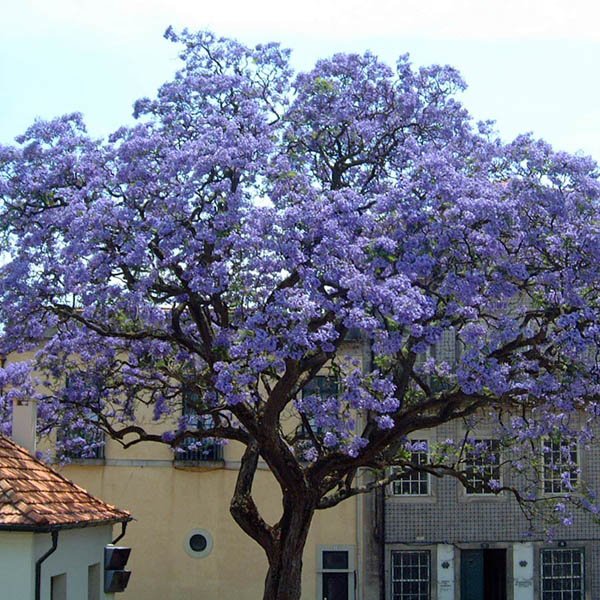

Botanical Name: Quercus
robur
Common Name: English oak
Family: Fagaceae
Distribution/Origin: most of Europe
Leaf: lobed, shortly stalked, alternate, simple
Bud: terminal clusters, scaled
Flower: separate male and female catkins
Fruit/Seed: dry, oval
Stem/Bark: deeply fissured greyish brown
Size: 50-60’ height, 10-20’ spread
Habit: spreading, branched
Form: open, rounded crown
Soil Conditions: well drained, deep, fertile, lime tolerant
Moisture: moist
Sun: full sun
Exposure: sheltered or exposed
Landscape Use: shade tree, residential streets, large meridians, accent
Notes: Latin for “oak” and “strength, hard timber”

Common Name: English oak
Family: Fagaceae
Distribution/Origin: most of Europe
Leaf: lobed, shortly stalked, alternate, simple
Bud: terminal clusters, scaled
Flower: separate male and female catkins
Fruit/Seed: dry, oval
Stem/Bark: deeply fissured greyish brown
Size: 50-60’ height, 10-20’ spread
Habit: spreading, branched
Form: open, rounded crown
Soil Conditions: well drained, deep, fertile, lime tolerant
Moisture: moist
Sun: full sun
Exposure: sheltered or exposed
Landscape Use: shade tree, residential streets, large meridians, accent
Notes: Latin for “oak” and “strength, hard timber”


Botanical Name: Robinia
psedoacacia ‘Purple Robe’
Common Name: purple robe
Family: Leguminosae /Fabaceae
Distribution/Origin: North America
Leaf: elliptic, oblong, odd pinnate compound, slender hairy petioles
Bud: alternate, when forming covered by base of petiole, minute, naked in 3’s and 4’s
Flower: pendant raceme, violet in color
Fruit/Seed: dry pod, black to red
Stem/Bark: lenticiles on new branches, thick deeply furrowed bark
Size: 30-50’ height, 20-35’ spread
Habit: irregular, upright, suckering
Form: oval, airy
Soil Conditions: well drained, prefers organically rich, can tolerate wide variety of soils
Moisture: consistent moisture
Sun: full sun to partial shade
Exposure: drought tolerant, can be used in xeriscaping
Landscape Use: street tree, landscaping, naturalized setting
Notes: has nitrogen fixing bacteria on roots and is able to grow in poor soils
Common Name: purple robe
Family: Leguminosae /Fabaceae
Distribution/Origin: North America
Leaf: elliptic, oblong, odd pinnate compound, slender hairy petioles
Bud: alternate, when forming covered by base of petiole, minute, naked in 3’s and 4’s
Flower: pendant raceme, violet in color
Fruit/Seed: dry pod, black to red
Stem/Bark: lenticiles on new branches, thick deeply furrowed bark
Size: 30-50’ height, 20-35’ spread
Habit: irregular, upright, suckering
Form: oval, airy
Soil Conditions: well drained, prefers organically rich, can tolerate wide variety of soils
Moisture: consistent moisture
Sun: full sun to partial shade
Exposure: drought tolerant, can be used in xeriscaping
Landscape Use: street tree, landscaping, naturalized setting
Notes: has nitrogen fixing bacteria on roots and is able to grow in poor soils
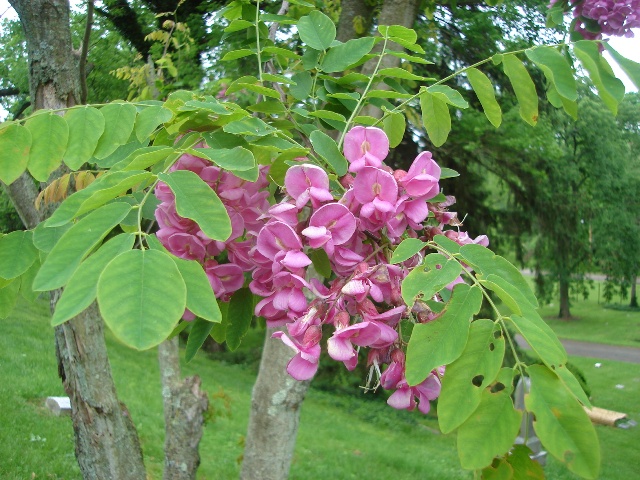
Botanical Name: Robinia
pseudoacacia
Common Name: black locust
Family: Fabaceae
Distribution/Origin: eastern United States
Leaf: parallel, compound, odd pinnate, slender hairy petioles
Bud: alternate, thorns present at base
Flower: perfect, loose drooping racemes, cream-white
Fruit/Seed: two valved legume, seeds dark orange
Stem/Bark: grey, brown tinged with red, deeply furrowed, thorns
Size: 40-70’ height, 25-35’ spread
Habit: upright
Form: oval, vertical
Soil Conditions: well drained, adapted to wide variety
Moisture: even moisture, drought tolerant
Sun: full sun
Exposure: sheltered from high winds
Landscape Use: ornamental, large lots, shade tree
Notes: pioneers used it to fashion nails for ships and houses

Common Name: black locust
Family: Fabaceae
Distribution/Origin: eastern United States
Leaf: parallel, compound, odd pinnate, slender hairy petioles
Bud: alternate, thorns present at base
Flower: perfect, loose drooping racemes, cream-white
Fruit/Seed: two valved legume, seeds dark orange
Stem/Bark: grey, brown tinged with red, deeply furrowed, thorns
Size: 40-70’ height, 25-35’ spread
Habit: upright
Form: oval, vertical
Soil Conditions: well drained, adapted to wide variety
Moisture: even moisture, drought tolerant
Sun: full sun
Exposure: sheltered from high winds
Landscape Use: ornamental, large lots, shade tree
Notes: pioneers used it to fashion nails for ships and houses


Botanical
Name: Robinia pseudoacacia ‘Frisia’
Common Name: Frisia
Family: Fabaceae
Distribution/Origin: Europe, garden origin
Leaf: compound, odd pinnate, elliptic and oblong
Bud: alternate, thorns at base
Flower: raceme, showy, white, pendulous
Fruit/Seed: brown black legume
Stem/Bark: dark grey, deeply fissured, red spines on new growth, lenticils present
Size: over 30’ height, over 30’ spread
Habit: twiggy, upright
Form: columnar, oval, vertical
Soil Conditions: rock, dry, gravelly, well drained
Moisture: dry to medium
Sun: full sun to partial shade
Exposure: brittle branches, needs shelter from high winds
Landscape Use: shade tree, summer interest, background
Notes: black locust is highly valued as firewood for wood-burning stoves; it burns slowly, with little visible flame or smoke


Common Name: Frisia
Family: Fabaceae
Distribution/Origin: Europe, garden origin
Leaf: compound, odd pinnate, elliptic and oblong
Bud: alternate, thorns at base
Flower: raceme, showy, white, pendulous
Fruit/Seed: brown black legume
Stem/Bark: dark grey, deeply fissured, red spines on new growth, lenticils present
Size: over 30’ height, over 30’ spread
Habit: twiggy, upright
Form: columnar, oval, vertical
Soil Conditions: rock, dry, gravelly, well drained
Moisture: dry to medium
Sun: full sun to partial shade
Exposure: brittle branches, needs shelter from high winds
Landscape Use: shade tree, summer interest, background
Notes: black locust is highly valued as firewood for wood-burning stoves; it burns slowly, with little visible flame or smoke


Botanical Name: Tilia
Americana
Common Name: American linden
Family: Tiliaceae
Distribution/Origin: eastern North America
Leaf: simple, ovate to cordate, unequal base, serrated margin, red hairs on veins
Bud: winter buds stout, ovate-acute, smooth and deep red with 2 bud scales visible, alternate
Flower: drooping cymose clusters, fragrant, perfect
Fruit/Seed: small nutlets with wings
Stem/Bark: vertical plates, doesn’t splinter easily
Size: 50-70’ height, 30-45’ spread
Habit: spreading, arching, irregular
Form: ovate, rounded crown
Soil Conditions: fertile, well drained loams
Moisture: average medium
Sun: full sun to partial shade
Exposure: intolerant of pollution, not a good street tree
Landscape Use: lawn space, shade tree
Notes: linden trees rot easily and have many cavities that serve as nesting places for birds

Common Name: American linden
Family: Tiliaceae
Distribution/Origin: eastern North America
Leaf: simple, ovate to cordate, unequal base, serrated margin, red hairs on veins
Bud: winter buds stout, ovate-acute, smooth and deep red with 2 bud scales visible, alternate
Flower: drooping cymose clusters, fragrant, perfect
Fruit/Seed: small nutlets with wings
Stem/Bark: vertical plates, doesn’t splinter easily
Size: 50-70’ height, 30-45’ spread
Habit: spreading, arching, irregular
Form: ovate, rounded crown
Soil Conditions: fertile, well drained loams
Moisture: average medium
Sun: full sun to partial shade
Exposure: intolerant of pollution, not a good street tree
Landscape Use: lawn space, shade tree
Notes: linden trees rot easily and have many cavities that serve as nesting places for birds


Botanical Name: Tilia
cordata
Common Name: little leaf linden
Family: Tiliaceae
Distribution/Origin: Europe
Leaf: cordate, simple, serrate margins, pinnate venation
Bud: alternate, red with scales, no terminal bud present
Flower: loose drooping clusters, light yellow creamy color, fragrant, leaf like bracts
Fruit/Seed: dry nut like drupe, downy at first and then becoming smooth with maturity
Stem/Bark: smooth when young, firm with ridges and horizontal fissures
Size: 60-70’ height, 35-50’ spread
Habit: dense compact branching, upright and spreading
Form: oval to pyramidal
Soil Conditions: well drained, acidic, clay, loam, sand
Moisture: medium moisture, slight drought tolerance
Sun: sun to partial shade
Exposure:
Landscape Use: street tree, shade tree, screen
Notes: a lightweight wood frequently used in medieval carvings, common in Windsor castle
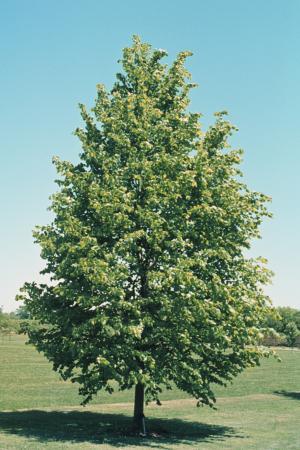
Common Name: little leaf linden
Family: Tiliaceae
Distribution/Origin: Europe
Leaf: cordate, simple, serrate margins, pinnate venation
Bud: alternate, red with scales, no terminal bud present
Flower: loose drooping clusters, light yellow creamy color, fragrant, leaf like bracts
Fruit/Seed: dry nut like drupe, downy at first and then becoming smooth with maturity
Stem/Bark: smooth when young, firm with ridges and horizontal fissures
Size: 60-70’ height, 35-50’ spread
Habit: dense compact branching, upright and spreading
Form: oval to pyramidal
Soil Conditions: well drained, acidic, clay, loam, sand
Moisture: medium moisture, slight drought tolerance
Sun: sun to partial shade
Exposure:
Landscape Use: street tree, shade tree, screen
Notes: a lightweight wood frequently used in medieval carvings, common in Windsor castle


Botanical Name: Tilia
tomentosa
Common Name: silver linden
Family: Tiliaceae
Distribution/Origin: south eastern Europe, western Asia
Leaf: simple, double serrate, cordate, pinnate venation, underside densely tomentose
Bud: alternate, downy, loose scales
Flower: pale yellow, cymes, fragrant
Fruit/Seed: dry, oval, drupe, slightly ribbed
Stem/Bark: grey-brown, deeply furrowed with age
Size: 50-70’ height, 40-60’ spread
Habit: multiple trunks, dense
Form: oval canopy, tight upright oval shape
Soil Conditions: well drained, adapted to wide variety of soils
Moisture: moderate
Sun: full sun to partial shade
Exposure:
Landscape Use: shade tree, specimen, large space
Notes: often used by Germanic tribes for constructing shields

Common Name: silver linden
Family: Tiliaceae
Distribution/Origin: south eastern Europe, western Asia
Leaf: simple, double serrate, cordate, pinnate venation, underside densely tomentose
Bud: alternate, downy, loose scales
Flower: pale yellow, cymes, fragrant
Fruit/Seed: dry, oval, drupe, slightly ribbed
Stem/Bark: grey-brown, deeply furrowed with age
Size: 50-70’ height, 40-60’ spread
Habit: multiple trunks, dense
Form: oval canopy, tight upright oval shape
Soil Conditions: well drained, adapted to wide variety of soils
Moisture: moderate
Sun: full sun to partial shade
Exposure:
Landscape Use: shade tree, specimen, large space
Notes: often used by Germanic tribes for constructing shields


Botanical Name: Ulmus
americana
Common Name: American elm
Family: Ulmaceae
Distribution/Origin: eastern North America
Leaf: doubly serrate, oblique base, elliptic to oval
Bud: alternate, ovate, reddish brown with darker edged scales
Flower: drooping clusters
Fruit/Seed: flat samara, circular papery wing surrounding single seed
Stem/Bark: dark ashy grey, flat topped ridges separated by fissures,
Size: 65-100’ height,
Habit: limbs strongly arching, ending in graceful drooping branchlets
Form: umbrella like canopy, vase shaped
Soil Conditions: well draining, fertile
Moisture: consistent moisture
Sun: sun to partial shade
Exposure:
Landscape Use: shade tree, street tree if monitored
Notes: because the dried wood is relatively odourless, it was used to make crates and barrels for cheeses, fruits and vegetables

Common Name: American elm
Family: Ulmaceae
Distribution/Origin: eastern North America
Leaf: doubly serrate, oblique base, elliptic to oval
Bud: alternate, ovate, reddish brown with darker edged scales
Flower: drooping clusters
Fruit/Seed: flat samara, circular papery wing surrounding single seed
Stem/Bark: dark ashy grey, flat topped ridges separated by fissures,
Size: 65-100’ height,
Habit: limbs strongly arching, ending in graceful drooping branchlets
Form: umbrella like canopy, vase shaped
Soil Conditions: well draining, fertile
Moisture: consistent moisture
Sun: sun to partial shade
Exposure:
Landscape Use: shade tree, street tree if monitored
Notes: because the dried wood is relatively odourless, it was used to make crates and barrels for cheeses, fruits and vegetables


Botanical Name: Ulmus
glabra ‘Camperdownii’
Common Name: wych elm
Family: Ulmaceae
Distribution/Origin: Europe
Leaf: obovate, double serrate, rough upper side, grow in bunches
Bud: alternate, brown, covered in small stiff hairs
Flower: compact groupings, green, single petal
Fruit/Seed: small winged nutlet,
Stem/Bark: silver grey, smooth in youth, darker grey with black grooves in maturity
Size: 4-7m height, 4-7m spread
Habit: weeping, broad spreading, irregular branching, dense
Form: broad, dome shaped crown, wide, low canopy
Soil Conditions: well draining, sandy, alkaline
Moisture: even moisture
Sun: full sun
Exposure:
Landscape Use: focal point in parks, larger landscapes, garden interest
Notes: in 1840 was discovered as a contorted elm in Scotland by the Earl of Camperdowns head forester. He brought it back to the gardens of the Camperdown house, to where it remains to this day. Every Camperdown elm in the world is descended as cuttings taken from the original tree and grafted.

Common Name: wych elm
Family: Ulmaceae
Distribution/Origin: Europe
Leaf: obovate, double serrate, rough upper side, grow in bunches
Bud: alternate, brown, covered in small stiff hairs
Flower: compact groupings, green, single petal
Fruit/Seed: small winged nutlet,
Stem/Bark: silver grey, smooth in youth, darker grey with black grooves in maturity
Size: 4-7m height, 4-7m spread
Habit: weeping, broad spreading, irregular branching, dense
Form: broad, dome shaped crown, wide, low canopy
Soil Conditions: well draining, sandy, alkaline
Moisture: even moisture
Sun: full sun
Exposure:
Landscape Use: focal point in parks, larger landscapes, garden interest
Notes: in 1840 was discovered as a contorted elm in Scotland by the Earl of Camperdowns head forester. He brought it back to the gardens of the Camperdown house, to where it remains to this day. Every Camperdown elm in the world is descended as cuttings taken from the original tree and grafted.


No comments:
Post a Comment